 |
Hazardous
Incident
|
 |
Hazardous
Incident
|
Hazardous Incident Information
for the Public: Is it Useful?
Abstract
In many countries legislation requires chemical companies to inform the public about risks of a plant and about emergency measures. The paper reports the results of an evaluation study on the efficacy of such information. With regard to the effects of hazardous incident information it turns out that it can contribute to more knowledge about hazardous incident warnings and appropriate emergency behaviour. Negative effects of hazardous incident information on residents' risk perception did not arise in the study. Rather, the findings suggest that informing the public about risks can increase trust in a company. Based on these results conclusions are drawn for giving hazardous incident information to the public.
Hazardous Incident Information
for the Public: Is it Useful?
The chemical industry is fundamental to modern societies. But it also poses many hazards, as disasters such as Bhopal or Seveso have shown. Informing the public about chemical hazards is therefore an important task – not only to promote emergency preparedness, but also because of the public's right to know about potential hazards.
Providing the public with information about toxic chemicals is in many countries of the world a statutory obligation for operators of chemical plants or for the responsible authorities. However, the way in which this information is provided differs greatly. In the USA, for example, the 1986 "Emergency Planning and Community Right to Know Act" gives citizens the right to be informed about certain chemicals potentially hazardous to health which are listed in the Toxic Release Inventory (TRI). Companies that process or store such substances must actively make regular reports on emissions on these chemicals (e.g. via paper reports or the Internet). There are other legally guaranteed opportunities of access to information on environmental risks through the Freedom of Information Act (Baram 1991). In Australia, the National Pollutant Inventory (NPI) gives citizens the opportunity of informing themselves about chemicals potentially hazardous to health even if to a much more modest extent than in the USA (Lloyd-Smith 1999).
In Europe, the adoption of the Seveso Directive (88/610/EEC) in 1988 also introduced the responsibility of informing citizens on the risks of those chemical plants which are subsumed under this directive for member states of the European Community (Art. 8 § 1). The individual member states implemented these standards in their respective national law at different speeds and in various ways (Wiedemann & Henschel 1998). In Germany, the Seveso Directive was implemented in 1991 within the framework of the Hazardous Incident Ordinance which regulates the operation of hazardous facilities. In Article 11a of the Hazardous Incident Ordinance, the companies to which the Hazardous Incident Ordinance applies are legally bound to inform the public about risks, accident warnings and appropriate accident behaviour (Wiedemann 1992).
While these legal requirements provide a basis for hazard information programs, they of course do not guarantee their success. As for other risk communication activities, careful evaluation is needed to assess the effectiveness of hazardous incident information (Rohrmann 1998).
This paper reports the results of two evaluation studies on the efficacy of hazardous incident information (HII) in Germany. In particular, the following topics were addressed:
Design of the empirical studies
The Waldhof plant of Boehringer Mannheim, a large pharamceutical company in Germany, served as an example of a plant to which the Hazardous Incident Ordinance applies.
For the first study (S1), a prototype of the HII brochure was developed consisting of a four-page information leaflet and an emergency information sheet printed on both sides. The brochure gives general comments on the purpose of this hazardous incident information as well as on the Waldhof plant and the products manufactured there. Furthermore, the information leaflet contained more detailed information on the risks of the chemical substances used in the plant and the production process as well as on safety and risk management measures taken by Boehringer Mannheim. Finally, the information leaflet also provided information on the way in which local residents would be warned of an accident and advice on appropriate behaviour. In the emergency sheet, accident warnings and accident behaviour were then represented separately on one page each with pictograms.
S1 was conducted in autumn 1992 as a combined cross-sectional and longitudinal study. The target population was local residents close to Boehringer Mannheim's Waldhof plant. First of all, the hazardous incident information (i.e. information leaflet and emergency sheet) was sent to 600 randomly selected residents (time t0). From these 600 persons, a random sample of 204 persons was taken who were interviewed by telephone a week later (time t1). 154 of these 204 persons were then interviewed again four weeks later (time t2). Furthermore, an additional 101 persons, also selected at random, who had not received any hazardous incident information, were then interviewed. Figure 1 shows the design of the studies.
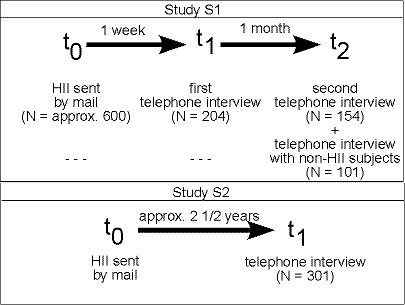
Figure 1: Design of the studies
This combination of a cross-sectional and longitudinal study enables both the examination of changes over time with the variables of interest here as well as a verification of the effectiveness of hazardous incident information, with the group of persons who did not receive any hazardous incident information functioning as a control group (results of this first study have also been reported in Schütz & Wiedemann 1995).
The second study (S2) investigated the effects of an official HII which was based on the prototype and which had been circulated by Boehringer Mannheim (and other local companies) about two and a half years previously. This study, conducted in autumn 1995, once again had local residents living close to Boehringer Mannheim's Waldhof plant as the target population. A random sample of 301 persons was interviewed although in this casee only one measuring time was planned. Since at the time of the survey all residents had received the hazardous incident information leaflet produced jointly by the companies in Mannheim, it was not possible for this study to include a control group of persons who had not received any hazardous incident information. The content of the joint information leaflet largely corresponded to the prototype of the S1 study described above. This study in particular tried to identify potential long-term effects of the given hazard information. Both S1 and S2 were conducted as telephone interviews on the basis of the questionnaire described.
Reception of the hazardous incident information
As described above, in S1 both a four-page information leaflet containing detailed information as well as an emergency sheet printed on both sides with information on warning signs and emergency behaviour measures had been distributed. Of the 204 persons interviewed in the first campaign (T1), 181 (88 .7 %) said that they had received this hazardous incident information. A total of 21 persons (10.3 %), however, said that they had not received the information, which actually means that they could not remember having received it (1 % no response).
In the second study (S2) performed two and a half years after an "official" HII had been sent to all residents, only 59 of the 301 persons interviewed (19.6 %) were able to recall having received the information leaflet; 139 persons (46.2 %) said that they had not received the hazardous incident information and 103 interviewees (34.2 %) couldn't remember or didn't make any response.
For those persons who said that they had received hazardous incident information, Table 1 shows the response frequencies.
Table 1: Reception of hazardous incident information in the two surveys
|
|
S2 | ||
|---|---|---|---|
| information leaflet | emergency sheet | information leaflet | |
| in full |
|
|
|
| in part |
|
|
|
| not at all |
|
|
|
| no response |
|
|
|
| Total |
|
|
|
The proportion of persons able to remember having received hazardous incident information is therefore very much lower in S2 than in S1 (19.6 % versus 88.7 %). It seems reasonable to attribute this difference to the considerably greater time lag between sending the hazardous incident information and conducting the interview. Apparently after a period of two and a half years many people can no longer remember having received hazardous incident information. Significantly enough, almost all those who can remember receiving the leaflet actually read it, at least in part, (91.6 %).
Studies on the public's need for information with respect to hazards repeatedly show that this demand is very great. This also becomes apparent in the S1 study: 63 % of the interviewees expressed their interest in more information on the topic. However, if the interviewers questioned them about practical action then this great need for information was significantly relativized since only 2.2 % of the interviewees said that they had actually made efforts to obtain further information while 93.9 % said that they had not. In the S2 study, only one single individual (of those persons who said that they had obtained information) had tried to get further hazardous incident information.
Assessment of the hazardous incident information
The assessment of the hazardous incident information in the S1 study was very positive. More than 90 % of the recipients rated the information leaflet and the emergency sheets as comprehensible and regarded the recommendations as meaningful.
This positive assessment was also reflected in the questions concerning the usefulness and credibility of the information given. Figure 2 summarises these results for the two surveys.
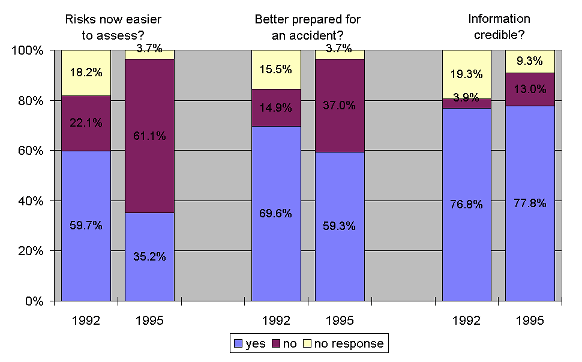
Figure 2: Assessment of the hazardous incident information in the two surveys (at time T1)
Influence of hazardous incident information on knowledge
With respect to the question of whether the information presented to the public on risks, hazard warnings and accident behaviour is actually effective, i.e. whether this information influences the knowledge and behaviour (or at least the potential behaviour) of the recipients in the desired manner, two aspects may be differentiated: on the one hand, the question of whether persons who have received information (i.e. have read it completely or at least in part) know more than those who have not received the information, and, on the other hand, the question of how long-lasting any knowledge effects are, that is, whether, or to what extent, hazardous incident information is recalled over a longer period of time.
The S1 study was designed in such a way that differences in knowledge between recipients and nonrecipients of hazardous incident information could be investigated as well as time effects; however, due to the limited study period it was not possible to record "genuine" long-term effects. In contrast, the S2 study offers the opportunity of estimating the extent of such long-term effects because in this case there was a gap of about two and a half years between distribution of the information and the survey.
In both studies knowledge about accident warnings and also about accident behaviour was covered by two batteries of items. Six different possibilities were given for the accident warnings, of which three were correct and three false. For accident behaviour ten options were given, of which three were correct and seven false. The respondents had to indicate whether a particular accident warning or accident behaviour was correct or false. The options are listed in Table 2.
Table 2: Options given for accident warnings and accident
behaviour
(correct answers are underlined)
| Accident warnings | Accident behaviour |
|---|---|
|
|
Knowledge about accident warnings
The S1 study identified differences in knowledge about accident warnings between recipients and nonrecipients of hazard information. For the purpose of this study recipients are defined as those subjects who had indicated that they had actually read the HII at least partly, while nonrecipients are those subjects who had actually not received the HII as well as those who said that they had not received the HII and those who said that they did receive the HII but did not read it.
Figure 3 reveals that the differences in knowledge are to be found above all in specifying the correct form of accident warnings. Significantly more recipients gave the correct answer here. In contrast, the differences for the incorrect accident warnings are slight and not statistically significant. However, it is apparent that the nonrecipients' level of knowledge is already relatively high since the majority of them also give the correct responses.
A similar picture emerges in the S2 study (see Figure 4). Here, recipients are again defined as those who said that they had read the HII at least partly, and nonrecipients as those who said they did not read it or said they did not receive the hazard information. In this case as well, the recipients of hazardous incident information give the correct forms of accident warnings more frequently than the nonrecipients; however, the differences here are only statistically significant for two warnings. Furthermore, a statistically significant difference also becomes apparent for an incorrect accident warning ("door-to-door information"). It is striking that the proportion of persons unable to make a response is higher in S2 than in S1.
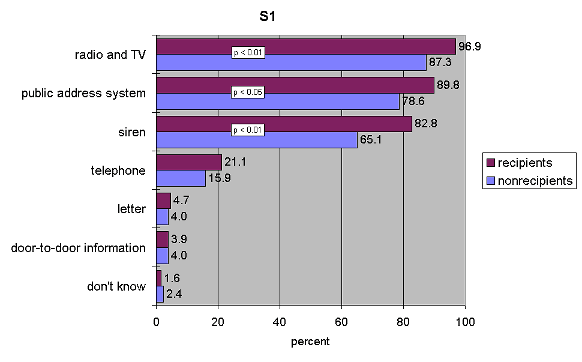
Figure 3: Recipients' and nonrecipients' knowledge on accident warnings in the S1 study
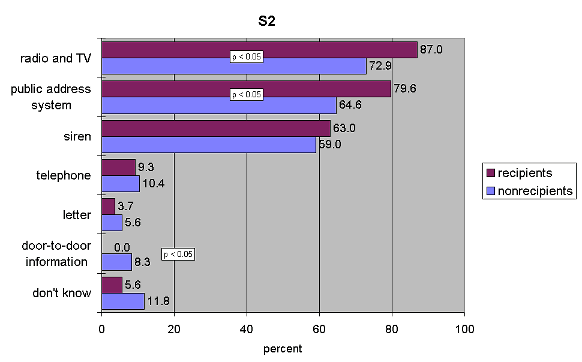
Figure 4: Recipients' and nonrecipients' knowledge on accident warnings in the S2 study
Knowledge on accident behaviour
Differences between recipients and nonrecipients of hazardous incident information also arose for knowledge on accident behaviour in the S1 study. Once again, recipients were able to specify the correct behaviour more frequently than nonrecipients; however, the differences are only statistically significant in one case ("go to a closed room"). There were also clear differences between recipients and nonrecipients with respect to incorrect behaviour. And apart from one exception, recipients give incorrect behaviour less frequently in all cases. These differences are statistically significant in four out of five cases (see Figure 5).
A quite similar picture emerges for the S2 study. Correct behaviour is specified more frequently by recipients and incorrect behaviour (with one exception) less frequently. As can be seen from Figure 6, the differences are perceptibly lower here and are not statistically significant in any of the cases.
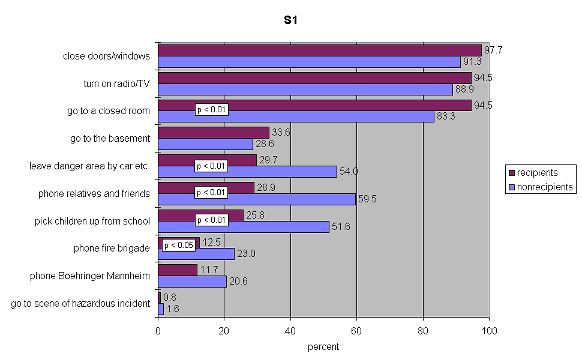
Figure 5: Recipients' and nonrecipients' knowledge on accident behaviour in the S1 study
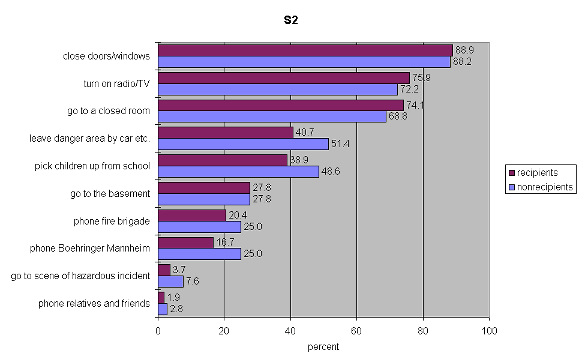
Figure 6: Recipients' and nonrecipients' knowledge on accident behaviour in the S2 study
Long-Term Effects: Memorableness of Hazardous Incident Information
In order to assess the long-term effect of hazardous incident information with respect to knowledge, the level of knowledge in survey S2 (where a period of about two and a half years had elapsed between distributing the hazardous incident information and examining the accident knowledge within the framework of the interview) was compared with that in S1 (where the information had only been provided one week previously). If there are fewer correct or more incorrect answers in S2 than in S1 then this can be regarded as an indication that the memorableness of hazardous incident information does indeed decrease with time. Of course, this comparison can only take those persons into consideration who had actually read the hazardous incident information. In the S1 study this applies to 98 of the respondents and 54 in S2.
Figure 7 shows that the percentage of persons who specified the three correct forms of accident warning (siren, public address system and TV/radio) in S2 was indeed lower than in the first interview (T1) and reinterview (T2) in S1. However, the three incorrect warnings were also mentioned less frequently in S2 even if the differences here are not so striking. A X2 test, in which the frequencies from the reinterview (T2) in S1 and from S2 were compared, indicates that these differences are only statistically significant for the "siren" warning.
It must be remembered here that in the sense of a longitudinal design a statistical comparison between S1 and S2 is not possible because this does not involve a panel study, i.e. the repetition of the survey with the same respondents. However, since a random sample was taken from the same population, these differences in the data can, with the necessary caution, certainly be attributed to the longer period between distribution of the hazardous incident information and verification of the accident knowledge.
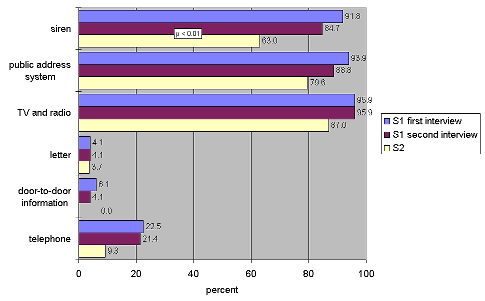
Figure 7: Recipients' knowledge on accident warnings in S1 and S2
It was similarly shown that with respect to the knowledge of accident behaviour (see Figure 8) the correct behaviour ("go to a closed room", "close doors and windows", "turn on radio/TV") was mentioned perceptibly less frequently than in S1. And these differences are all statistically significant (the X2 test was once again used to compare the data from the reinterview (T2) in S1 with S2). The picture is heterogeneous for the seven incorrect modes of behaviour: in some cases more incorrect answers were given in S2 and in other cases fewer. However, the differences between S1 (T2) and the interview in S2 are only statistically significant in two cases ("pick children up from school" and "phone relatives and friends").
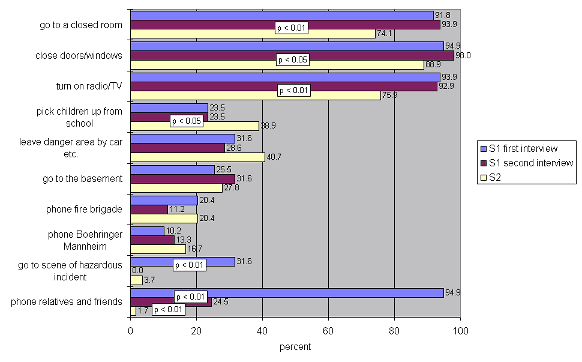
Figure 8: Recipients' knowledge on accident behaviour in S1 and S2
Risk perception
A potentially "hazardous" side effect of hazardous incident information is that the latter may itself "negatively" influence risk perception. In order to discover whether such an effect of the reception of hazardous incident information on risk perception can actually be substantiated two questions concerning the probability of an accident were posed in both studies. First of all, a question was posed concerning an assessment of the probability with which an accident affecting local residents could occur at Boehringer Mannheim within the next five years. The respondents were asked to express their opinion by giving a maximum of ten points (0 points = accident impossible ... 10 points = accident certain). In another question the respondents were asked (once again by giving 10 points) about the probability that the respondent would be personally affected by such an accident.
In the S1 study, no negative effect of hazardous incident information on risk perception was established (see Figure 9). On average, risk assessment by recipients of hazardous incident information did not differ from that of persons who had not read the information. For the (first) question concerning the probability of an accident, the average for the recipients is x = 3.75 and for the nonrecipients x = 3.85; i.e., the difference between the two groups is slight and not statistically significant. For the (second) question concerning being personally affected, the average for recipients is x = 5.16 and for nonrecipients x = 5.40; this difference is not statistically significant either.
In the S2 study, the question of the probability of an accident in the next five years leads to an average of x = 3.09 for recipients and for nonrecipients the average is x = 3.93. The difference between the two groups is statistically only marginally significant (t test; t = -1.81; df = 195; p = 0.061). With respect to the question of the probability of being personally affected by an accident, an average of x = 4.15 is found for recipients of the hazardous incident information and x = 5.07 for nonrecipients. This difference in averages is not statistically significant (see Figure 9).
It can therefore be said that neither in the S1 nor S2 study can a "negative" effect of hazardous incident information on risk perception (in the sense of increasing the perceived level of risk) be observed. In fact, those persons who have read the hazardous incident information tend to judge the risk to be less severe, both in a general and also personal risk assessment, than those persons who have not read the hazardous incident information.
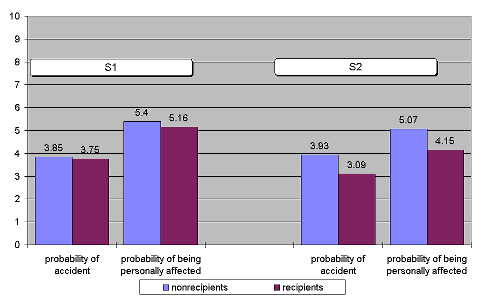
Figure 9: Risk perception (averages)
Another aspect of risk perception also studied here concerns the assessment of the possibilities for one's own self-protection, i.e. the question was posed of the extent to which the respondents believed that they could protect themselves in the case of an accident. Since the HII drew attention to such possibilities of protection, it was expected that recipients would make a more positive assessment of possible self-protection measures than nonrecipients.
In S1 the percentage of recipients with a positive assessment of self-protection possibilities of 70.3 % is indeed greater than that of the nonrecipients at 51.6 % (see Figure 10). This difference is highly statistically significant (X2 = 10.04; df = 2; p = 0.0066).
The same trend can be found in S2 as in S1: recipients of hazardous incident information tend to arrive more frequently at a positive assessment than nonrecipients (64.8 % versus 50.7 %; see Figure 10). However, this difference cannot be statistically supported.

Figure 10: Assessment of self-protection opportunities
In spite of certain differences in the two surveys concerning individual aspects of risk perception, one characteristic emerges quite clearly. At least in the case considered here, hazardous incident information does not lead to heightened risk perception. In fact, even with respect to the possibilities of protecting oneself in the case of an accident, recipients of hazardous incident information more frequently have a positive assessment than nonrecipients.
Trust and Credibility
A further aspect, of major significance for risk communication and management, is the trust in a company's ability to control risks.
Thus in both studies respondents were asked about their "trust in the efforts of Boehringer Mannheim to keep the risks for humans and the environment as low as possible". The assessment was to be made on a 0 - 10 point scale. On the whole, the average value of x = 6.55 reflected considerable trust. If, however, a differentiation is made between recipients and nonrecipients of hazardous incident information then it becomes apparent that on average (x = 6.96) recipients have more confidence in Boehringer Mannheim's efforts at reducing risk than the nonrecipients (x = 6.07). This difference is statistically significant (t test: t = 2.82; df = 242; p = 0.005). In the S2 survey, an even clearer difference between recipients and nonrecipients emerges for the same question, which is also statistically highly significant (t test: t = 3.41; df = 127; p = 0.001).
On the whole, the results of this evaluation study show that informing the public about accident risks, warnings and behaviour can have a positive influence on knowledge concerning this topic. In addition, providing hazard information may help to increase trust of the public in a company's risk management competence. In the following some topics will be discussed which deserve particular attention to in order to improve the efficacy of hazardous incident information.
Concerning the recollection of hazardous incident information after a considerable period, the results of this study indicate that the availability of accident knowledge decreases over time. This is in line with other studies on risk information which also found a decrease in knowledge over time (Mossman et al., 1990; van Eijndhoven et al., 1994). Thus it seems reasonable to provide HII periodically as is, in fact, required by the German Hazardous Incident Ordinance. However, the results of this study suggest that the time span between two information campaigns should be much shorter than the three years which are at present prescribed in Germany. This is also important because there is little reason to expect that many people will actively strive for hazard information. Although in this study a majority of subjects expressed the need for more hazard information, which is in line with results of previous studies in France (Lalo 1990), Portugal (Nicolau 1990) and Italy (De Marchi 1991), only a few subjects indicated that they had actually made efforts to obtain more information.
It should be noted that this evaluation study did not (and could not) investigate whether providing hazardous incident information will improve the actual emergency behaviour of residents. It is certainly questionable whether information about emergency warnings and behaviour alone will provide a sufficient basis for emergency preparedness. Indeed, interviews with risk management experts from German companies and agencies which had been conducted in the course of the study showed that these experts considered practising emergency behaviour with residents as particularly important for managing hazardous incidents. While the experts were sceptical whether residents could be motivated to participate in accident training exercises, they also emphasised that a HII type of information could promote insight in the importance of such exercises.
The results of this study also do not give any grounds for fears that information about risks might involve undesirable side effects in the form of increasing the level of perceived risk. Obviously, the participants of this study were anyway well aware of living next to a potentially dangerous facility and the risk information given in the HII did not influence their risk perception dramatically. This is consistent with other findings suggesting that people who themselves have direct experience of a hazardous facility are not so much affected by additional risk information as are people who lack direct experience (Wiegman, Gutteling & Boer, 1991).
For the interpretation and generalizability of these results it has to be taken into account that the population from which our samples were drawn might be rather specific with respect to attitudes towards Boehringer Mannheim and experience with the Waldhof plant. Our data show - and this is supported by a number of additional qualitative interviews conducted prior to the evaluation study - that attitudes towards Boehringer Mannheim are basically quite positive. Moreover, there have been no hazardous incidents during the last twenty years. Thus our subjects have hardly had any opportunity to personally experience negative effects from the plant. In addition, many subjects may have profited more or less directly from Boehringer Mannheim by working there themselves or having relatives or friends who do so. All this may have contributed to the positive effects of this study and we can only speculate as to what results would have been obtained in a more problematic or troublesome situation.
Irrespective of these reservations, the results of this study show that (preventive) hazardous incident information as stipulated in the German Hazardous Incident Ordinance, is useful for informing the public or local residents about accident risks, accident warnings and correct accident behaviour. This is particularly significant in view of current political and legal developments in instructing the public via hazardous incident information.
The Seveso II Directive (96/82/EC), adopted by the European Commission in December 1996 and currently being implemented in the European states, requires additional information measures from the companies concerned. Thus, for example, the companies' safety analysis reports must be made accessible to the public and local residents must be consulted in drawing up the companies' external contingency plans. Anecdotal evidence suggests that many chemical companies (at least in Germany) are still reluctant to address risk issues in their communication with the public and are particularly sceptical with regard to the new information requirements of the Seveso II Directive. However, the results of the evaluation studies reported here suggest that such risk information efforts may be worthwhile, not only because of the legal requirements but also because they may increase confidence and ultimately improve the companies' image and relationship with the community.
The study was supported by the German Umweltbundesamt (Federal Environmental Agency). We would like to thank Janet Gough and Bernd Rohrmann for helpful comments.
Baram, M. (1991): Rights and duties concerning the availability of environmental risk information to the public. In: R.E. Kasperson and P.J.M. Stallen (eds.), Communicating risks to the public. International perspectives. Dordrecht: Kluwer, 67-78.
De Marchi, B. (1991): The Seveso Directive: An Italian pilot study in enabling communication. Risk Analysis, 11 (2), 207-215.
Lalo, A. (1990): Informing the public on major technological risks: Communication strategies of the Bouches-du-Rhone campaign, April-June 1989. In: H.B.F. Gow and H. Otway (eds.), Communicating with the public about major accident hazards. London: Elsevier Science Publishers, 204-231.
Lloyd-Smith, M. (1999): Community Right to Know and FOI in Chemical Management. Paper presented at the conference 'Freedom of Information and the Right to Know' held in Melbourne on August 19-20 1999. (Source: http://www.comslaw.org.au/research/Equity/19990913_lloydsmithfoi.html)
Mossman, G.K., Follows, A., Fisher, R.W. & Humphreys, D. (1990): Control of industrial major accident hazards (CIMAH) regulations - information to the public: A local authority emergency planning perspective. In: H.B.F. Gow and H. Otway (eds.), Communicating with the public about major accident hazards. London: Elsevier Science Publishers, 96-102.
Nicolau, J.A. (1990): Public information for major industrial accidents. In: H.B.F. Gow and H. Otway (eds.), Communicating with the public about major accident hazards. London: Elsevier Science Publishers, 232-245.
Rohrmann, B. (1998): Assessing hazard information/communication programs. Australian Psychologist, 33, 105-112.
Schütz, H. & Wiedemann, P.M. (1995): Implementation of the Seveso Directive in Germany - An evaluation of Hazardous Incident Information. Safety Science, 18, 203-214.
Van Eijndhoven, J.C.M., Weterings, R.A.P.M., Worrell, C.W. et al. (1994): Risk communication in The Netherlands: The monitored introduction of EC "post Seveso" Directive. Risk Analysis, 14, 87-96.
Wiedemann, P.M. (1992): Vorgehensweise bei der Umsetzung der Seveso-Direktive in Deutschland. Chemie-Technik, 21 (12), 58-65.
Wiedemann, P.M. & Henschel, C. (1998): Implementing the Seveso Directive: Problems and progress. In: P.C.R. Gray, R.M. Stern and M. Biocca (eds.), Communicating about risks to environment and health in Europe. Dordrecht: Kluwer Academic Publishers, 83-105.
Wiegman, O., Gutteling, J.M. & Boer, H. (1991): Verification of information through direct experience with an industrial hazard. Basic and Applied Social Psychology, 12, 325-340.
| Comments to Trauma.Webmaster@massey.ac.nz Massey University, New Zealand URL: http://www.massey.ac.nz/~trauma/ |
Disclaimer
Last changed October
13, 2000 |